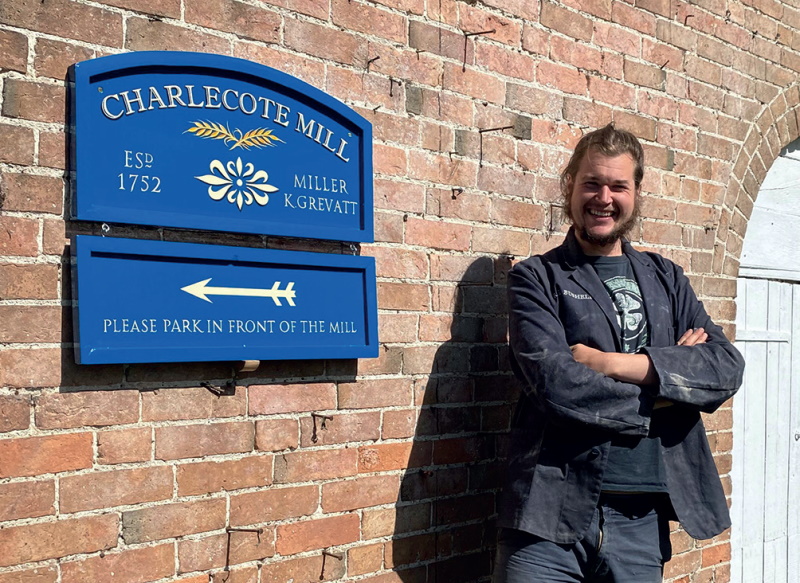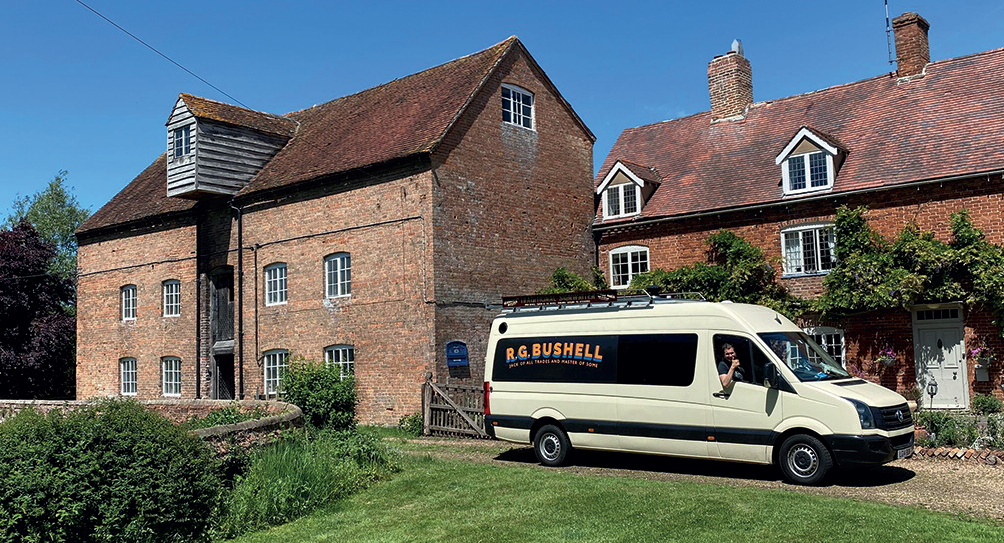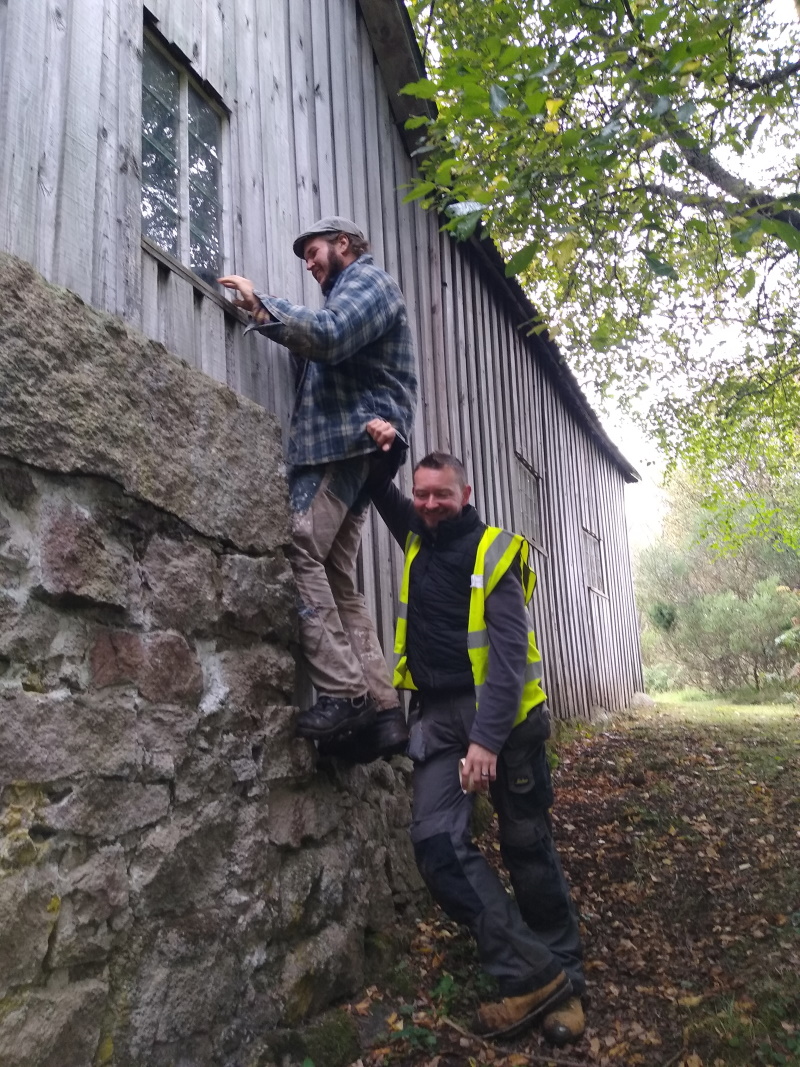2022 SPAB Fellow Owen Bushell is a shingle maker and signwriter, and he is also this year's Millwrighting Fellow. One SPAB Fellow a year gets the opportunity for an additional three months’ training in millwrighting, now an endangered craft. He recounts his experiences so far...
My background can best be described as multi-disciplinary! I'm currently a sole trader specialising in traditional signwriting and I produce Austrian-style shingles from larch in the Scottish Highlands. Not much to do with mills, I hear you cry! Perhaps not. My background is with railways. Firstly as a volunteer on the North Norfolk Railway (NNR), where in a past life I have been a qualified steam locomotive driver. It was here, hiding away in the workshops as a teenager, that I picked up signwriting as well as a firm grounding in practical mechanical engineering and restoration. Through the NNR I was a Signalman for Network Rail for nearly a decade and worked, in the last years before closure, the last mechanical signal boxes in my native county of Norfolk.
Owen next to a new sign he painted for Charlecote Mill, Warwickshire. Credit: Karl Grevatt
Following in the footsteps of last year's millwright trainee, Toby Slater, my training has so far been focused primarily in England, with an equal split between wind and water mills.
I began with two weeks at Charlecote Mill near Stratford-Upon-Avon, with past SPAB Fellow Karl Gravatt. Charlecote is a two-wheeled commercial flour mill from c.1750. Having never set foot in a flour mill it was a great surprise to find how intuitive the operation is: the grumbles and groans soon tell you if running is too fast or slow, or a grind too coarse or feed too slow. Just like a steam engine, it needs coaxing not coercion. Karl gave up a significant amount of time to explain the workings and maintenance regime of Charlecote, so it was a great pleasure to gift him a sign for the mill when the time came to move on.
Owen about to depart from Charlecote Mill, Warwickshire. Credit: Karl Grevatt
Through Karl, I was also introduced to the very knowledgeable John Bedington who kindly gave up a lot of time to take me out to Wickhamford Watermill for a day of maintenance, and Balsall Common, to demonstrate the basics of operating a windmill with shutters and canvas sails. Time in the Midlands would not be complete without a trip to Whissendine Windmill for an introduction to Nigel Moon, so a day was spent fettling sail post mortices on the new pair of sails under construction. Whissendine had recently had a huge section out of the wallower blow out, and was running on electric. One man's misery is another's opportunity – the misfortune provided an excellent chance to work out how to go about such repairs.
The winds blew me East, firstly to Norfolk and a fleeting visit to Richard Seago's outstanding post mill in South Walsham, and then on to Sibsey Trader Mill in Lincolnshire. Here I met Tim Whiting and the team at Suffolk Millwright, to join in with the final stages of a two-year project to completely rebuild a new cap. The wealth of knowledge on hand from Tim has been astounding. As a dedicated millwrighting contractor, Suffolk Millwright's work at Sibsey is incredibly impressive, for the care paid to architectural details, for the energy poured into seeing things done properly and for the scale of the operation, with some impressive plant machinery on hand needed for the impressive framework and brake wheel beneath the cap. Timber framing meets mechanical engineering! I was humbled to be let loose on working on much of the green British cedar cladding, giving the mill its distinctive ogee cap shape.
I then moved on to Oxfordshire and Owlsworth IJP's yard near Reading to spend a week working at Dumbleton Watermill, under the watchful eye of head millwright Paul Selwood, aptly aided by Karl Bettles, with a contract to replace the Pentrough in advance of a full rebuild of the wheel. Paul and Karl shared invaluable knowledge and it was a good project to explore repairs where budgets dictated the limits of restoring mechanical components. Any visit to Reading isn't complete without a visit to the Mills Archive, so time was spent exploring the archive before heading down the road.
A call came through from Tim Whiting to say the cap was to be lifted at Sibsey, so together with fellow Fellow David McFerran (who has worked on Ballycopeland Windmill), we peeled off from our programme and headed to Lincolnshire. It's not every day you get to see a cap lift. Within an hour the cap was on, standing tall above the fens – an incredible achievement.
Owen propped up by Fellow David McFerran at the SPAB Scotland Working Party at Fitzean Mills, Aberdeenshire.
After this there was an opportunity to visit Suffolk Millwright's workshop in Woodbridge, Suffolk. With sails for three mills in their final stages, totalling 14 frames, with more on the way, and numerous other repair projects, it is an impressive sight. There is nothing else like it in the UK. The job at hand for me and David was to assemble the new fantail for the iconic Cranbrook Mill in Kent, with good lessons in methodical millwrighting assembly: no hole never left unpainted and check and double check assembled components. Putting together a fantail is one thing, getting it to site is another so it was a good challenge to assemble a cradle for transporting it, too.
Since re-joining the main SPAB Fellowship programme, there has still been time for millwrighting. Highlights include a visit to recently renovated Warwick Bridge Mill near Carlisle and to Ballycopeland Windmill, with Fellow David McFerran on hand to interpret the unique survivor with roller-reefing gear.
There isn't much time for reflection during the programme owing to the non-stop intensity of it. What does stand out is the application of the SPAB's conservation philosophy and the way this is applied to mechanical components within mills, often with drastic consequences. This is a sizeable topic, but I would also like to highlight this inconsistency as it has been an interesting one to stumble across during the programme so far. It leads me to consolidate my belief that there are always many ways to do something, but normally only one way will ever really work in the long run, and that is to do the work properly first-time round!
By Owen Bushell. Follow him on Instagram.
A longer version of this article appeared in the October edition of Mill News.



